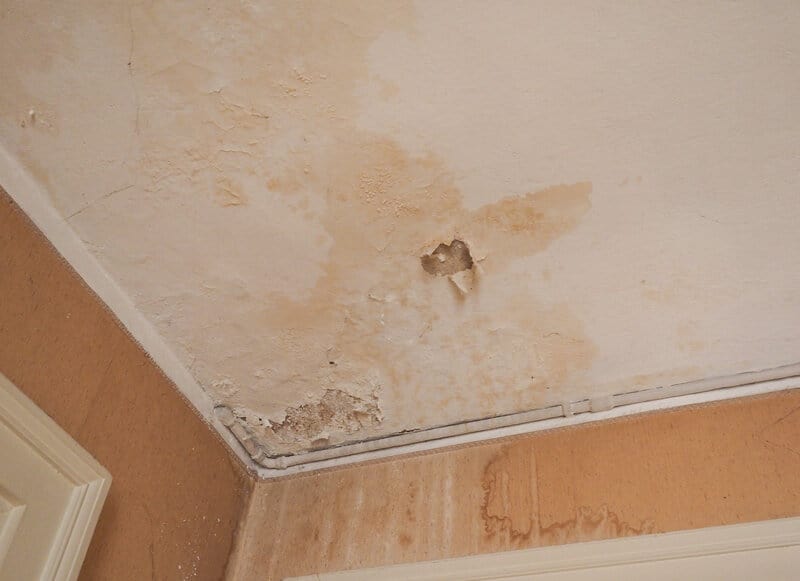
There’s a reason why it’s good to have a professional roof inspection at least once a year. It’s the best way to check for red flags that could lead to roof leaks or stop early roof leaks before they get out of hand. Even so, roof leaks are inevitable, so knowing where to keep an eye out and what to look for will help you identify a leak before it can do more damage.
The 5 Most Likely Places For Roof Leaks
Here are five of the most common areas for roof leaks.
The chimney
It’s easy to see when the seal around a door or window frame is missing or broken down. More often than not, you’ll notice a draft. The chimney is a different story. Most people never see anything but the exterior of their chimney, and even then, it’s not from an inspection standpoint. However, the chimney requires penetration into the roof’s anatomy. If it isn’t sealed correctly, water will make its way into the edges of that chimney penetration and down through the roof.
Chimney leaks can also occur due to:
- Cracks in the chimney
- Missing or damaged chimney cover
- Incorrectly installed or worn down chimney flashing
Leaky chimneys and faulty flashing account for two of our top 10 reasons your roof might be leaking. During an annual roof inspection, we closely look at the chimney flashing and the chimney itself and report if anything is amiss.
Broken or missing shingles
Your shingles aren’t there for looks. While colorful and decorative shingles are a hot item right now, their main purpose is to protect your roof and shed water down and away from your home. If shingles are missing, cracked, or damaged, water moves through them and travels in search of other weak areas it can penetrate. Always call a roofer if you notice signs of damaged or missing shingles.
If your home is more than 15 or 20 years old, odds are the broken and missing shingles are the sign it’s time to replace the roof. There’s no point in replacing shingles if the materials underneath them are compromised or worn out.
Poorly sealed roof valleys
As its name implies, a roof valley is where two downslopes of a roof meet to form a valley. In a storm or on a foggy day, water accumulates on the roof surface. The runoff is directed into the roof valleys and into the gutter and downspout system. That juncture must be carefully sealed to prevent water infiltration. Resealing joints like this is a common part of routine roof maintenance because they break down over time.
Cracked roof vents or seals
Your roof isn’t the only part of your home’s moisture protection plan. The roof, attic, and ventilation systems work together to keep interior temperatures and humidity levels stable and minimize moisture accumulation. Roof vents are those things that look like pipes sticking out of the roof and they are designed to move moisture out of your home.
Typically, roof vents are installed using flashing around the penetration and then a rubber boot to protect water and moisture from entering the vent at the top. A crack, damage, or corrosion of any of those features allows water to penetrate the roof.
Other penetration leaks
Just as your vent and chimney penetrate the roof, so do other roof features such as skylights or certain HVAC system parts. If those seals break down or the installers don’t adhere to current building codes, water infiltrates through gaps between the roof structure and the perimeter of the parts.
How Do I Know If My Roof Is Leaking?
When your ceiling is dripping, you know there is a problem. However, roof leaks can be much more sneaky than that. The most common signs of a roof leak are:
- You see water spots on your ceilings or walls.
- There are spots or signs of a previous leak in the attic.
- You see missing or damaged shingles, or it’s obvious the flashing is damaged (it’s only a matter of time if you don’t have a roof leak already).
- A nail (or more than one nail) penetrated through the roof and into the attic ceiling. These are called “shiners” and provide a clear path for water to travel through the roof and into the attic.
- There is mold growing where the roof meets an exterior wall
- Rusted gutters
Even if you don’t have a roof leak (yet), the above signs mean it is time to schedule a roof inspection with a licensed Bay Area roofer. The sooner you stop roof leaks, the less overall damage they can do. Plus, homeowners’ insurance companies are less likely to pay for the damage if it’s obvious the leak has gone ignored. Contact Pacific Coast Roofing Service and we’ll be happy to take a look for you.

